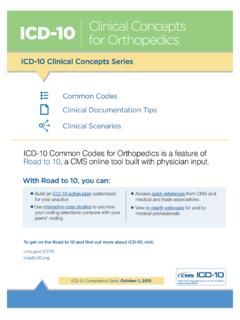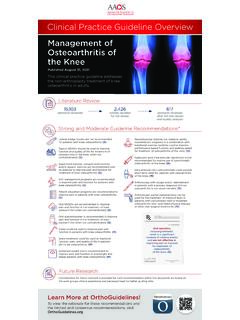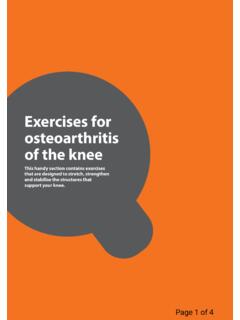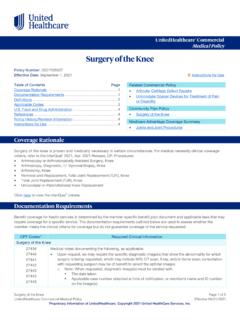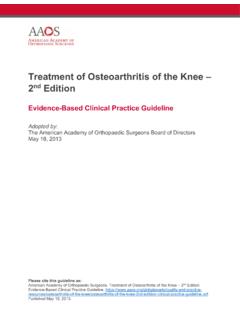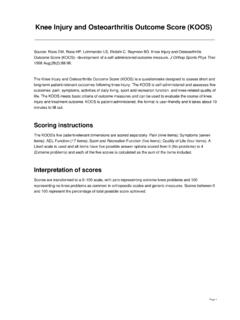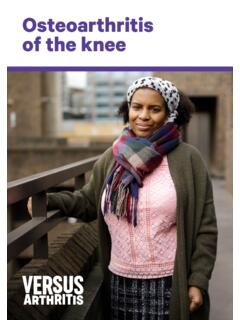Transcription of Osteoarthritis: Diagnosis and Treatment
1 January 1, 2012 Volume 85, Number 1 American Family Physician 49 osteoarthritis : Diagnosis and TreatmentKEITH SINUSAS, MD, Middlesex Hospital, Middletown, Connecticut osteoarthritis is a common degen-erative disorder of the articular cartilage associated with hyper-trophic changes in the Risk factors include genetics, female sex, past trauma, advancing age, and As the population ages and becomes more obese, family physicians can expect to see more patients with osteoarthritis . DiagnosisThe most common symptom of osteoarthri-tis is joint pain. The pain tends to worsen with activity, especially following a period of rest; this has been called the gelling phe-nomenon. osteoarthritis can cause morn-ing stiffness, but it usually lasts for less than 30 minutes, unlike rheumatoid arthritis, which causes stiffness for 45 minutes or Patients may report joint locking or joint instability.
2 These symptoms result in loss of function, with patients limiting their activities of daily living because of pain and joints most commonly affected are the hands, knees, hips, and spine, but almost any joint can be involved. osteoarthritis is often asymmetric. A patient may have severe, debilitating osteoarthritis of one knee with almost normal function of the opposite examination is important in making the Diagnosis . Pain on range of motion and limitation of range of motion are common to all forms of osteoarthritis , but each joint has unique physical examina-tion findings (Ta b l e 1). Figure 1 shows a hand with typical changes of osteoarthritis is primarily a clini-cal Diagnosis , physicians can confidently make the Diagnosis based on the history and physical examination.
3 Plain radiography can be helpful in confirming the Diagnosis and ruling out other Advanced imaging techniques, such as computed osteoarthritis is a common degenerative disorder of the articular cartilage associated with hypertrophic bone changes. Risk factors include genetics, female sex, past trauma, advancing age, and obesity. The Diagnosis is based on a history of joint pain worsened by movement, which can lead to disability in activities of daily living. Plain radi-ography may help in the Diagnosis , but laboratory testing usually does not. Pharmacologic Treatment should begin with acetaminophen and step up to nonsteroidal anti-inflammatory drugs. Exercise is a useful adjunct to Treatment and has been shown to reduce pain and disability. The supplements glucosamine and chondroitin can be used for moderate to severe knee osteoarthritis when taken in combination.
4 Corticosteroid injections provide inexpensive, short-term (four to eight weeks) relief of osteoarthritic flare-ups of the knee , whereas hyaluronic acid injections are more expensive but can maintain symptom improvement for longer periods. Total joint replacement of the hip, knee , or shoulder is recommended for patients with chronic pain and disability despite maximal medical therapy. (Am Fam Physician. 2012;85(1):49-56. Copyright 2012 American Academy of Family Physicians.) Patient information: A handout on osteoarthri-tis, written by the author of this article, is provided on page 1. Signs and Symptoms of OsteoarthritisHandPain on range of motionHypertrophic changes at distal and proximal interphalangeal joints (Heberden nodes and Bouchard nodes; Figure 1)Tenderness over carpometacarpal joint of thumbShoulderPain on range of motionLimitation of range of motion, especially external rotationCrepitus on range of motionKneePain on range of motionJoint effusionCrepitus on range of motionPresence of popliteal cyst (Baker cyst)
5 Lateral instabilityValgus or varus deformityHipPain on range of motionPain in buttockLimitation of range of motion, especially internal rotationFootPain on ambulation, especially at first metatarsophalangeal jointLimited range of motion of first metatarsophalangeal joint, hallux rigidusHallux valgus deformitySpinePain on range of motionLimitation of range of motionLower extremity sensory loss, reflex loss, motor weakness caused by nerve root impingementPseudoclaudication caused by spinal stenosisDownloaded from the American Family Physician Web site at Copyright 2012 American Academy of Family Physicians. For the private, noncom-mercial use of one individual user of the Web site. All other rights reserved. Contact for copyright questions and/or permission American Family Physician Volume 85, Number 1 January 1, 2012tomography or magnetic resonance imaging, are rarely needed unless the Diagnosis is in doubt and there is a strong suspicion for another etiology, such as a meniscal injury.
6 Figures 2 through 4 show examples of radiog-raphy of the hand, hips, and testing usually is not required to make the Diagnosis . Markers of inflamma-tion, such as erythrocyte sedimentation rate and C-reactive protein level, are typically nor-mal. Immunologic tests, such as antinuclear antibodies and rheumatoid factor, should not be ordered unless there is evidence of joint inflammation or synovitis, which makes autoimmune arthritis a more likely Diagnosis . A uric acid level is recommended only if gout is suspected. Because false-positive results are possible, ordering some of these tests may add unnecessary confusion if the pretest prob-ability of gout or an autoimmune arthritis is ,5 Rheumatic panels ( , erythrocyte sedimentation rate, rheumatoid factor, anti-nuclear antibodies, uric acid, Lyme serology in some areas) have an especially high rate of false-positive results in primary care popula-tions.
7 An American College of Rheumatol-ogy clinical guideline recommends against the routine ordering of arthritis panels for patients with joint choices fall into four main cat-egories: nonpharmacologic, pharmacologic, complementary and alternative, and surgi-cal. In general, Treatment should begin with the safest and least invasive therapies before proceeding to more invasive, expensive therapies. All patients with osteoarthritis should receive at least some Treatment from the first two categories. Surgical manage-ment should be reserved for those who do 2 Figure 2. Radiograph of a hand affected by osteoarthritis showing (1) joint space narrow-ing, (2) osteophytes, and (3) joint destruction. Also note changes at carpometacarpal joint (4), which are very common in 3.
8 Radiograph of the hips showing (1) joint space narrowing and (2) osteophyte 1. Hand affected by osteoarthritis . (1) Heberden nodes. (2) Bouchard 1, 2012 Volume 85, Number 1 American Family Physician 51not improve with behavioral and pharma-cologic therapy, and who have intractable pain and loss of practice guidelines have been recommended by American and British spe-cialty , 8 Figure 5 presents a stepped-care approach to treating osteoarthritis . NONPHARMACOLOGICN onpharmacologic therapy often starts with exercise. A randomized clinical trial compared supervised home-based exercise with no exercise in 786 patients with osteo-arthritis of the knee . The exercise program consisted of muscle strengthening and range-12 AFigure 4.
9 Radiograph of the knee in (A) anteroposterior and (B) lateral views showing (1) joint space narrowing and (2) osteophyte Approach for the Treatment of OsteoarthritisBegin with acetaminophen and continue if still effective, or step up to NSAIDD iscuss total joint replacement for osteoarthritis of the hip, knee , or shoulder if steps below are unsuccessfulConsider hyaluronic acid injection for persistent knee osteoarthritisConsider corticosteroid injection for acute exacerbation of knee osteoarthritisConsider opioid therapy, but monitor carefully for dependence and abuseAdd combination glucosamine and chondroitin for moderate to severe knee osteoarthritis ; discontinue if no change after three months, but continue if effect is notedStart NSAID therapy, beginning with over-the-counter ibuprofen or naproxen; switch to different NSAID if initial choice is not effective; use generics if possibleEncourage regular exercise throughout Treatment and encourage weight loss if patient is overweight or obeseConsider physical therapy referral for supervised exercise (land- or water-based); consider bracing and splintingMild osteoarthritisModerate osteoarthritisSevere osteoarthritisFigure 5.
10 Recommended stepped-care approach for the Treatment of osteoarthritis . (NSAID = nonsteroidal anti- inflammatory drug.)Osteoarthritis52 American Family Physician Volume 85, Number 1 January 1, 2012of-motion exercises. The researchers found statistically significant improvements in a validated arthritis symptom score at six, 12, 18, and 24 Cochrane review of exercise for osteo-arthritis of the knee concluded that land-based exercise can result in short-term reduction of pain and improvement in phys-ical A similar Cochrane review of water-based exercise for knee and hip osteoarthritis showed improvement, but the results were not as A randomized controlled trial of 200 persons compared education by a primary care physician to exercise supervised by a physical therapist.










